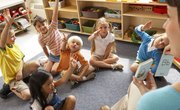Teachers who use top-down methods of instruction to teach students to learn to read, speak or write a language believe that language as a whole must be understood before individual words and parts of speech will be comprehended. Similar to how young children learn to speak, students are immersed in whole language. Over time, learners are able to extract meaning from words and context clues.
Reading for Meaning
In top-down literacy learning, teachers place more importance on reading for meaning than reading each word correctly. Instead of requiring new readers to attempt to decode a text word by word, texts are analyzed as a whole. Students do not need to understand the meaning or pronunciation of every word for comprehension to take place. Just as parents read books to babies with no expectation that the baby fully comprehends it, books, speeches or other literary works are explored as a whole to encourage reading for meaning.
Student Selection
Believing that a personal interest in a particular book or text will motivate readers, teachers encourage self-selection of materials. Students will naturally begin to make literary learning connections when absorbed in interesting material that is rich in vocabulary. Students will be encouraged to repeatedly examine books or listen to interesting speeches again and again. Over time, a familiarity with the material will help language and fluency skills to naturally develop.
Background Knowledge
Personal knowledge and background information help learners to decipher unknown words or meaning of a text as a whole. Context clues can also help students effectively process literature and spoken language. Oral language skills help students as they learn to decipher printed words, resulting in the learning of new vocabulary words. Students also use background knowledge to make predictions about what they expect to happen next in a book or other piece of text.
Interactive Activities
Teachers try to use instructional time to work on meaningful activities that give students interactive opportunities to practice and improve literacy skills through reading and writing exercises. Speaking and listening skills are also encouraged, and the teacher will not stop oral readers to correct mistakes. Mistakes are seen as a good thing as teachers believe it proves that a student is willing to take a risk and begin to try to learn new words.
Related Articles
References
Writer Bio
Amy Pearson earned dual bachelor's degrees in management and horticulture. She is a licensed elementary teacher for kindergarten through sixth grades. Pearson specializes in flower and vegetable gardening, landscape design, education, early childhood and child development.











